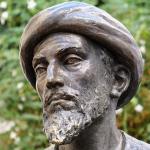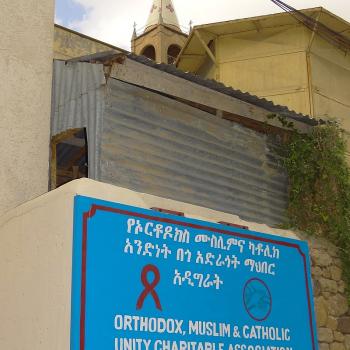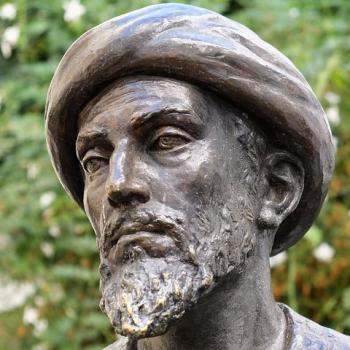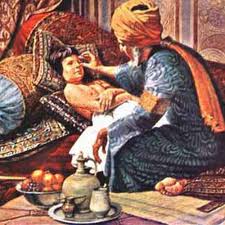 Al- Razi (Rhazes): Considered one of the brightest physicians, he was a philosopher, alchemist and musician. His most notable writing is The Comprehensive Book on Medicine (Kitab al-Hawi fi al-tibb)- a large notebook with extracts from earlier authors regarding diseases and therapeutics. In addition he recorded clinical cases of his own experience. The material comprising the Hawi is arranged under headings of different diseases, with separate sections on pharmacological topics.
Al- Razi (Rhazes): Considered one of the brightest physicians, he was a philosopher, alchemist and musician. His most notable writing is The Comprehensive Book on Medicine (Kitab al-Hawi fi al-tibb)- a large notebook with extracts from earlier authors regarding diseases and therapeutics. In addition he recorded clinical cases of his own experience. The material comprising the Hawi is arranged under headings of different diseases, with separate sections on pharmacological topics.
From National Library of Science:
His Comprehensive Book on Medicine, the Hawi, was translated into Latin in 1279 under the title Continens by Faraj ben Salim, a physician of Sicilian-Jewish origin employed by Charles of Anjou to translate medical works. Even more influential in Europe was al-Razi’s Book of Medicine Dedicated to Mansur, a short general textbook on medicine in ten chapters which he had dedicated in 903 (290 H) to the Samanid prince Abu Salih al-Mansur ibn Ishaq, governor of Rayy. The treatise was translated into Latin in Toledo by Gerard of Cremona (d. 1187) and was known as Liber ad Almansoris. It became one of the most widely read medieval medical manuals in Europe, and the ninth chapter, on therapeutics, frequently circulated by itself under the title Liber nonus ad Almansorem. In the Renaissance many editions of it were printed with commentaries by the prominent physicians of the day, such as Andreas Vesalius.
(Al Razi picture: courtesy of historyofalchemy.com)
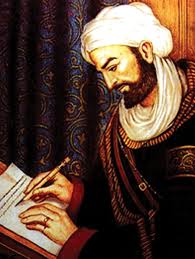 Ibn Sina (Avicenna 980-1037)
Ibn Sina (Avicenna 980-1037)
Probably the most well known from the era, he was born in Afshana, Bukhara (currently Uzbekistan and lived in Persia in his early life. He was a polymath, a physician, a theologian, astronomer and a mathematician-among others. He was a prolific writer and is believed to have written over 450 books, of which about 250 have survived. His most influential book is Al-Qanun fi al-Tibb, or Code of Laws in medicine, commonly known as the Canon of Medicine. It is a 5-volume encyclopedia that covers the principles of Medicine, diseases of various parts of the body, general diseases and fractures. It remained in use in medical schools in Europe until the 17th century.
Here is a small excerpt from the National Library of Medicine.
The Canon of Medicine was widely read by Europeans in the Latin translation of Gerard of Cremona made in the 12th century. So great was the interest in this mammoth medical textbook that late in the 15th century Girolamo Ramusio attempted to improve upon Gerard of Cremona’s Latin translation by comparing it with an Arabic manuscript, and in 1527 a new Latin version was published that had been made by Andrea Alpago (d. 1522), who had resided in Damascus for thirty years as a physician in the service of the Venetian Republic and had used his fluency in Arabic not only to translate it but also to append an Arabic-Latin glossary of terms. Between 1500 and 1674 some sixty editions of part or all of the Canon were published in Europe, mostly intended for use in university medical training.
When he died in 1037 he was known as one of the greatest philosophers of Islam, and in medicine he was so highly regarded that he was compared to Galen.
In honor of his immense contributions, especially in Medicine and Philosophy, UNESCO celebrated the thousand year anniversary of his birth in 1980.
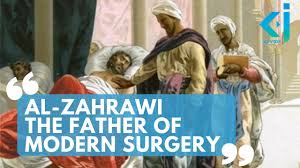 Al-Zahrawi (936-1013)
Al-Zahrawi (936-1013)
Born in Cordoba, Andalusia, he is probably the most famous surgeon from the medieval and Middle ages. He is best known for revolutionizing surgical procedures and surgical instruments. His principal work is the Kitab al-Tasrif, a thirty-volume encyclopedia of medical practices, covering Surgery, Medicine, Pharmacology, pathology, Ophthalmology and Obstetrics, among others. The surgery volume in this encyclopedia was later translated into Latin where it received popularity and became the standard textbook in Europe for the next 500 years.
Al-Zahrawi’s pioneering contributions to the field of surgical procedures and instruments had an enormous impact in the East and West well into the modern period, where some of his discoveries are still applied in medicine to this day. [3]
His contributions include:
- First physician to describe abdominal pregnancy ( a type of ectopic pregnancy-meaning fetus growing in sites other than the usual uterus implantation).
- First physician to describe the hereditary nature of hemophilia.
- On Surgery and instrumentation is the last volume of his encyclopedia, Al Tasrif, which details surgical procedures, how to perform them, and contains the pictures of the surgical instruments that are still in use. He introduced numerous surgical procedure for trauma, neurosurgery, obstetrics and other areas, and over 200 surgical instruments. He introduced catgut for internal stitching, which is still used as a self-dissolving form of suturing. He revolutionized surgical procedures in being the first to perform procedures such as using bone replacement for lost teeth, surgical procedure for sagging breasts, using cotton to control bleeding, performing a tracheostomy and other innovative procedures for renal stones. He described how to remove a dead fetus by using forceps, and designed the vaginal specula. The list goes on but I hope you got the picture.
Next: EDUCATION AND UNIVERSITIES-The first degree-awarding university in the world.


